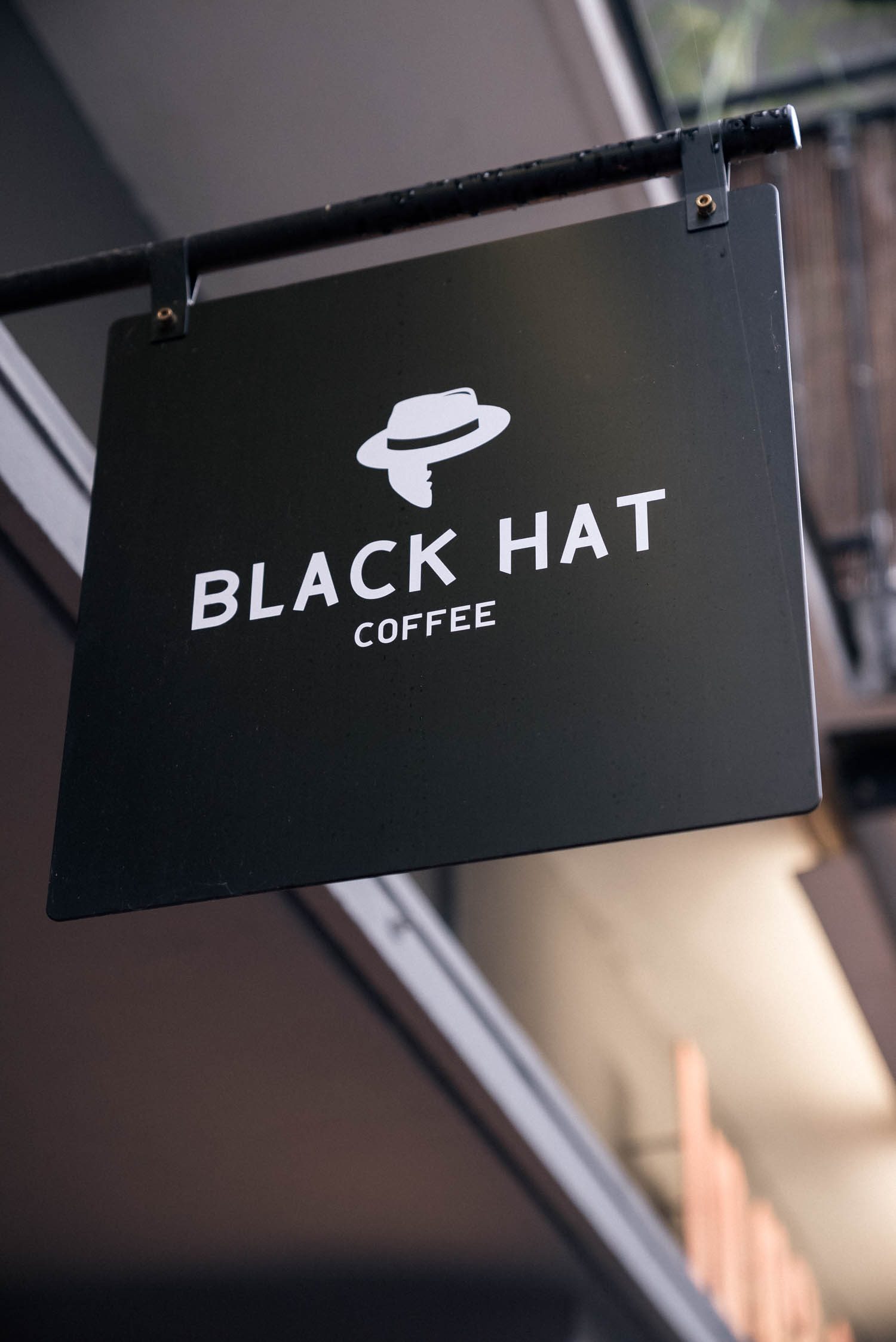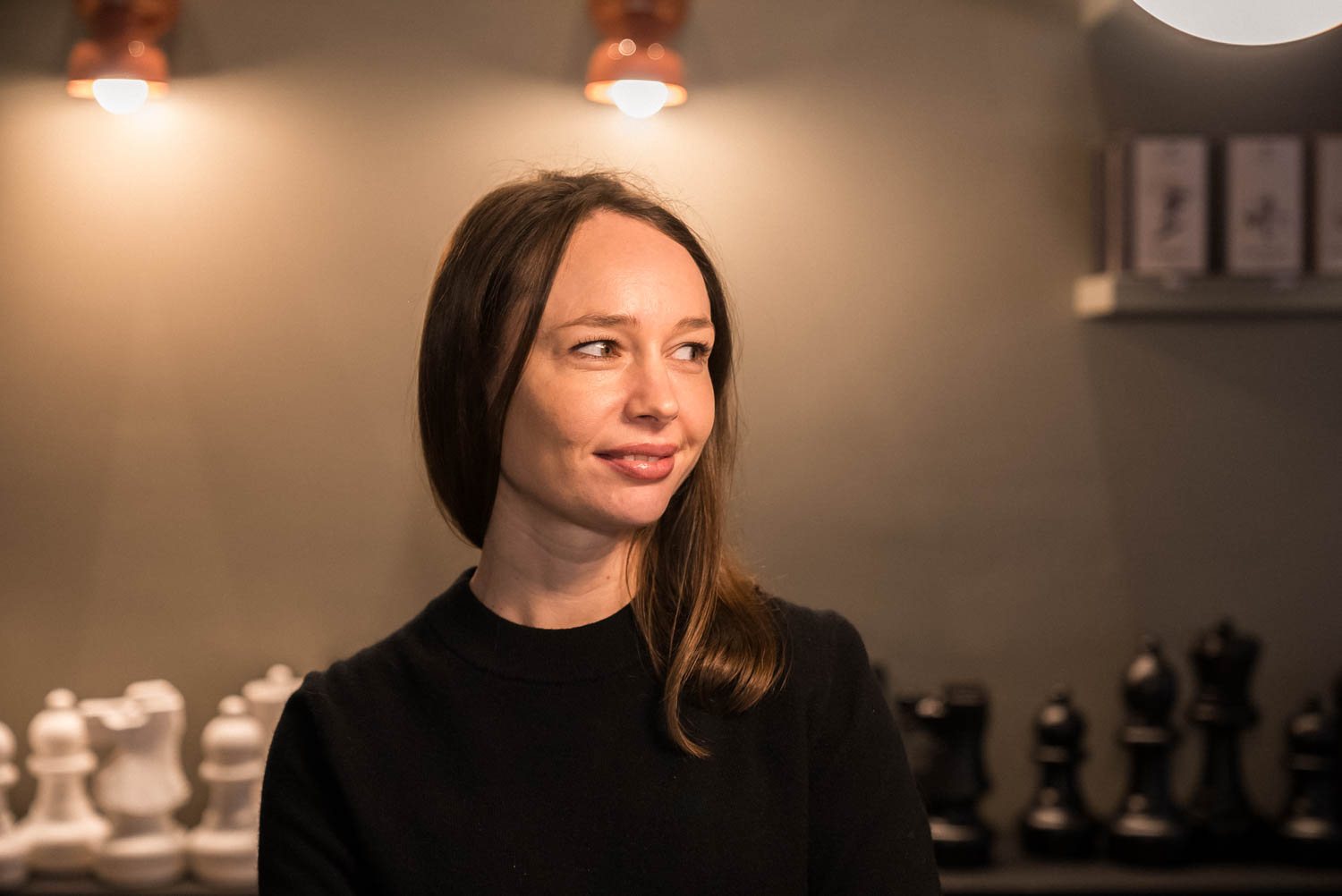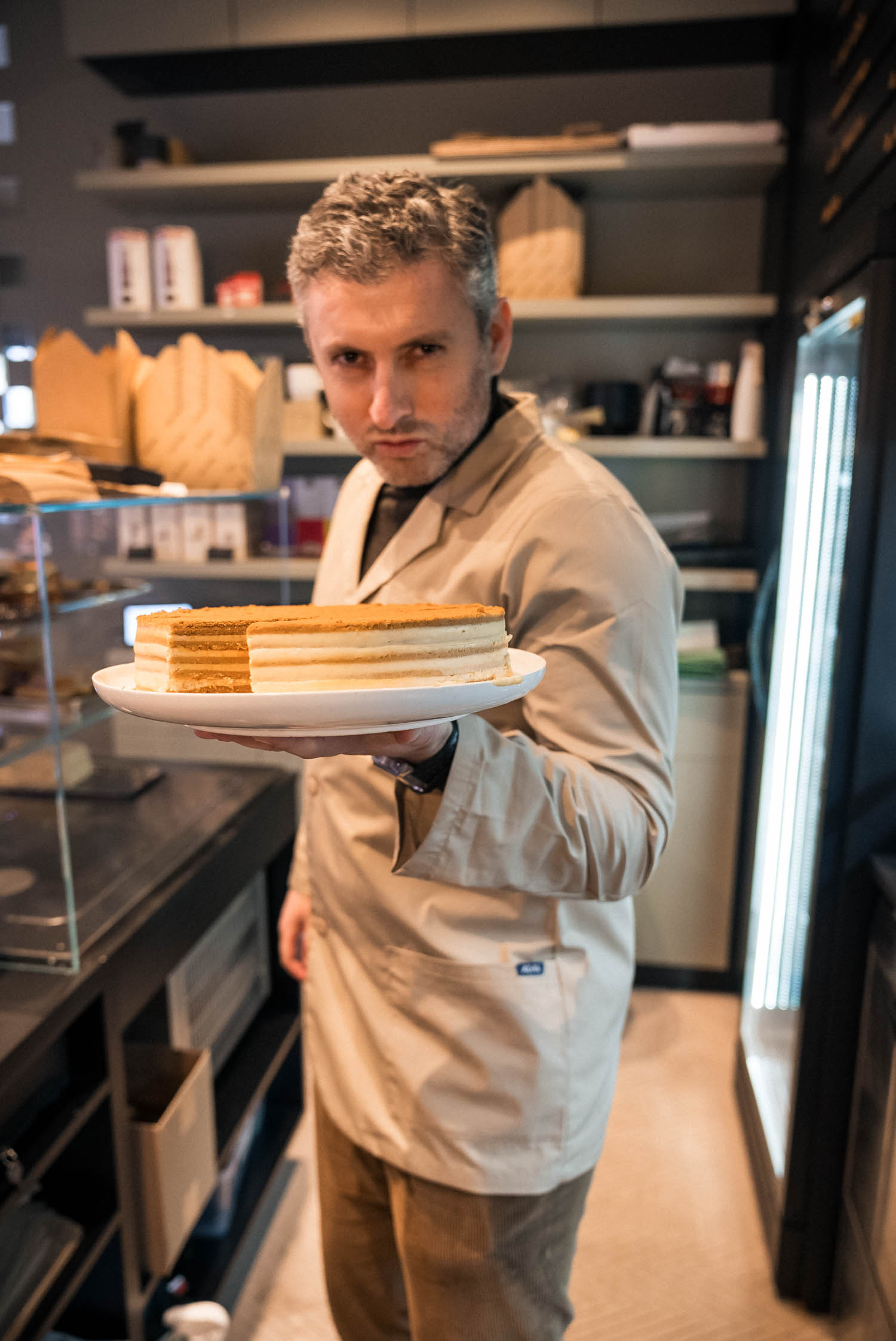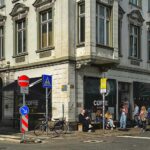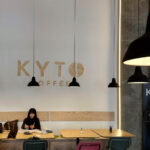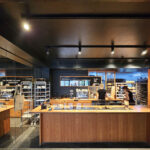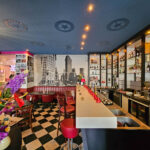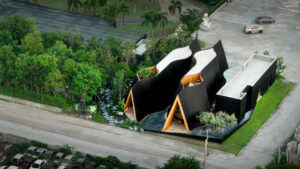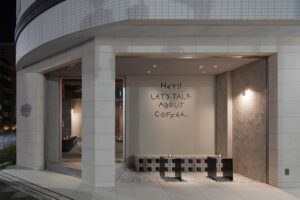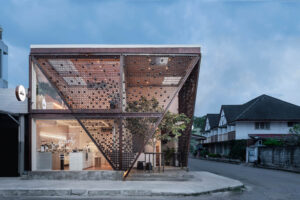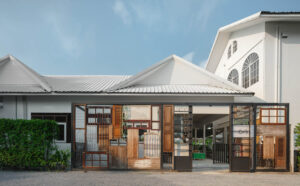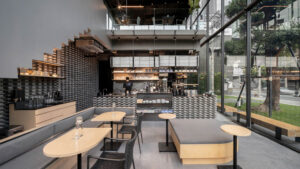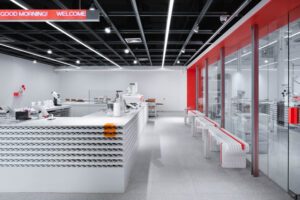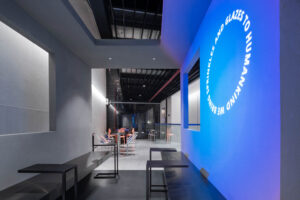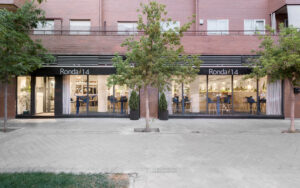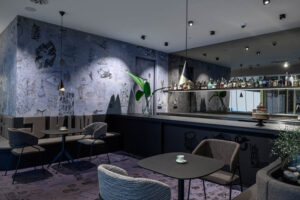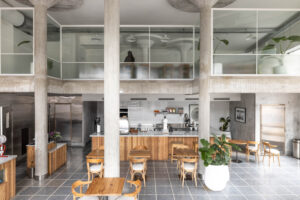Black Hat Coffee Specialty Espresso Bar in Hamburg
We recently connected with Slava and Inna Zamikhovska of Black Hat Coffee Specialty Espresso Bar. In true cross-cultural fashion, they are coffee entrepreneurs from Odessa, Ukraine, who have established Black Hat Coffee in Hamburg since 2018. In this interview, we discuss their journey in setting up the café, the design elements that resonate with them and their patrons, and how they are fostering a vibrant community of coffee lovers in Hamburg. Photographed by Moritz Lüdtke
To explore cafes worldwide see bestcafedesigns.com. A top 100 architectural blog and global directory of cafes and cafe professionals. Click here to see further European cafe designs.
Can you tell us the story behind how Black Hat Coffee started and how you and your husband, a Ukrainian couple, ended up in Hamburg?
Interestingly, Hamburg wasn’t the first German city we called home. My husband and his family immigrated to Germany in 2000, initially settling in Cologne. We lived there for several years as a married couple before moving to Frankfurt, then Munich, and finally Hamburg. We often joke that we’ve lived in every major German city except Berlin. Yet, for us, Hamburg is the most beautiful city in Germany and in many ways reminds us of our hometown, Odessa.
Before diving into the coffee business, I studied political science in Odessa, Ukraine. When I became pregnant, I moved to Germany in 2012 to join my husband, who had just completed his studies and was searching for his first job. In Germany, I took language courses, adjusted to my new life as a mother and wife in a foreign country, and spent a few years as a housewife. During this period, I also sold vintage jewelry, including Dior and Celine clip-ons from the 80s, through online platforms.
My husband and co-founder, Slava, worked in digital marketing at a media agency and often felt frustrated because, despite being busy all day, his work only produced reports, metrics, and digital outcomes with no tangible results. Both of us found it challenging to explain to our grandparents and parents exactly what we did for a living, which fueled our desire to create a physical, tangible product. This, combined with our love for coffee, visiting coffee shops, and the aspiration to work on a project together, inspired us to start our own coffee brand.
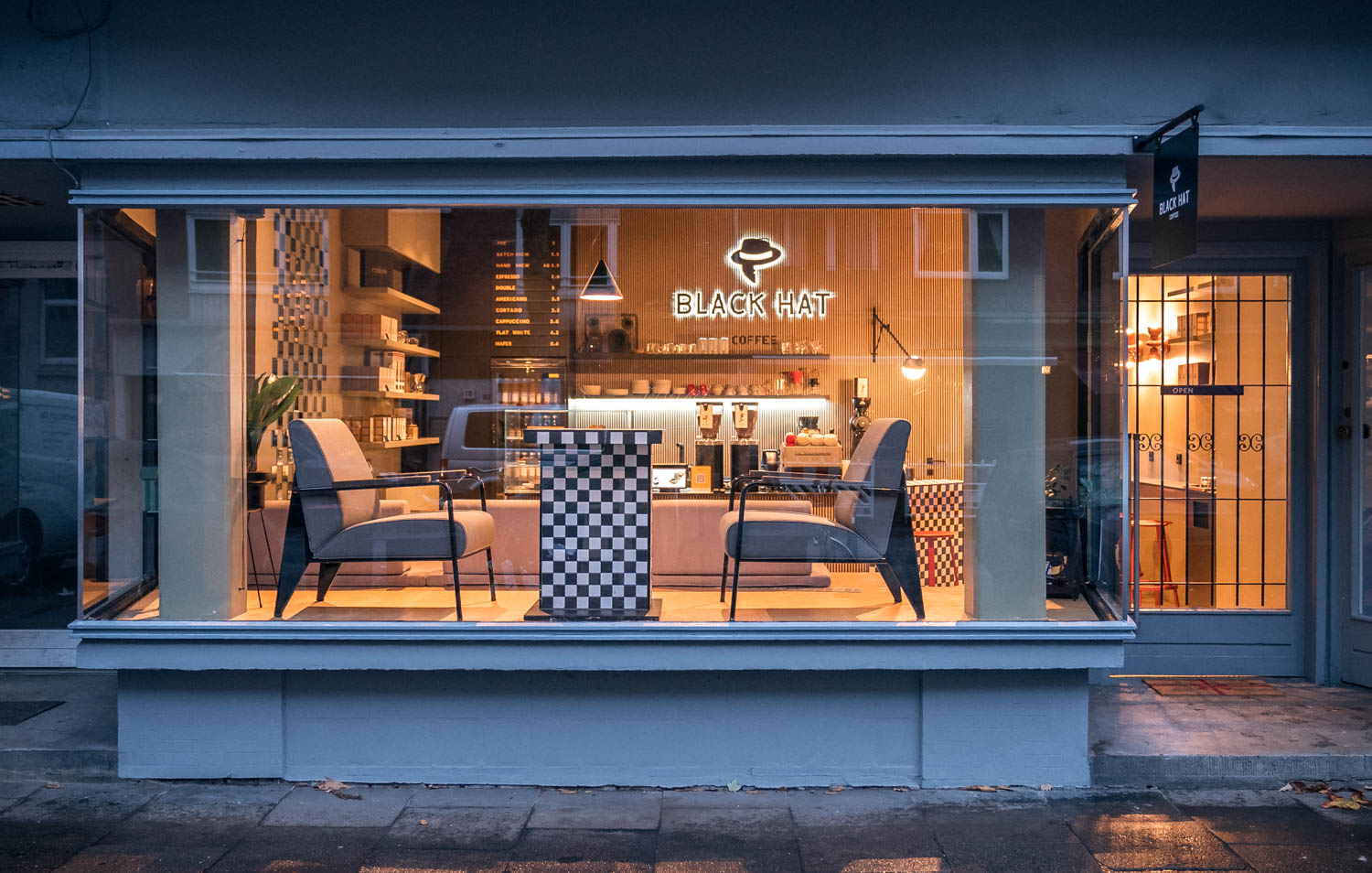
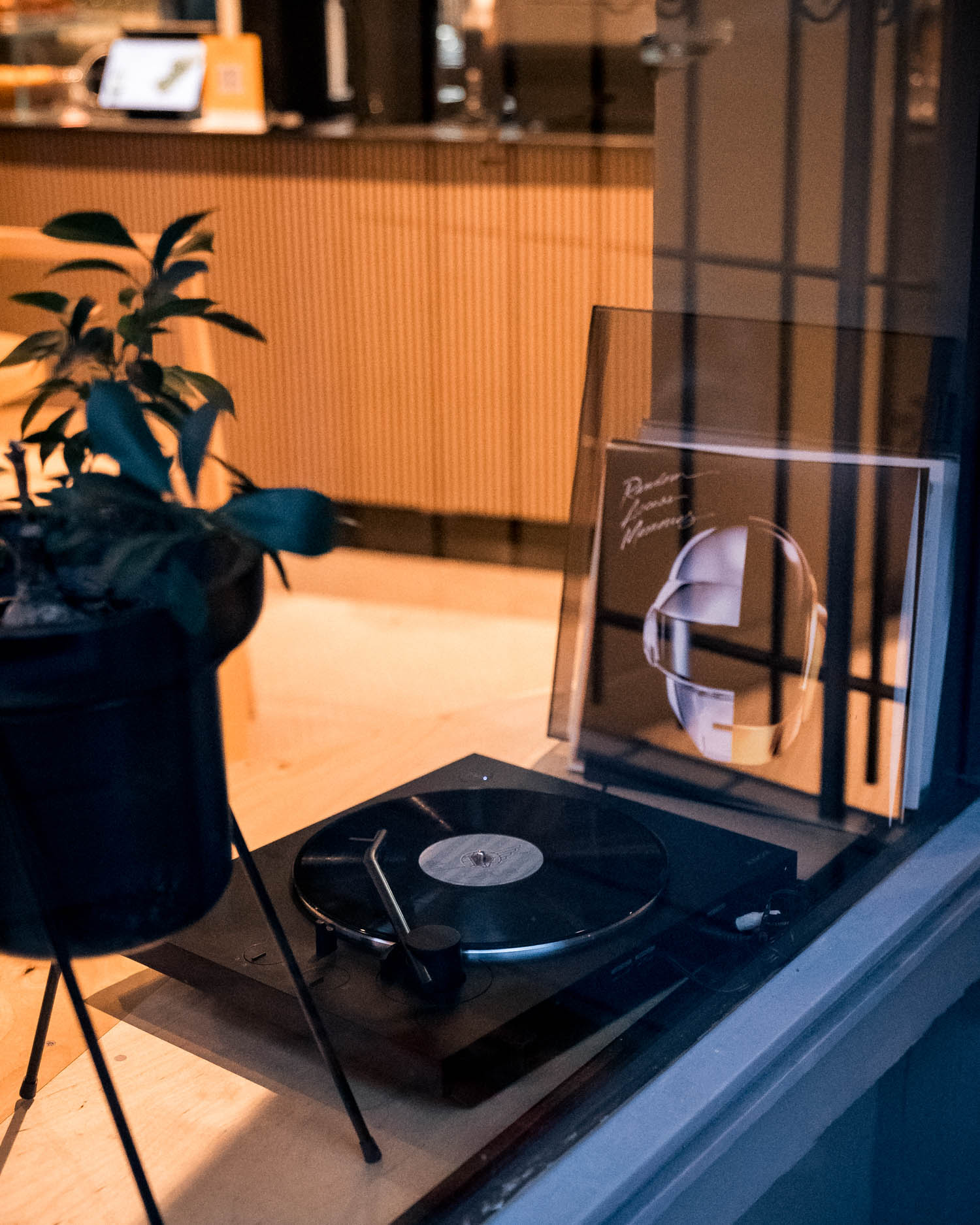
What were some of the initial challenges you faced when establishing Black Hat Coffee in a new country?
We started out as an online brand, but to give our customers a seamless online-offline experience, we added a mobile espresso bar that truly embodied our brand values. We spared no expense in selecting top-notch equipment: a custom GS3 made by Specht in Australia, a mobile espresso bar imported from the U.S., and we were among the first to receive the E65s GBW from Mahlkönig. Every detail of the design was meticulously planned.
Operating the mobile espresso bar was my debut as a barista. I took several courses and was deeply committed to mastering the craft. I practiced diligently at home every day before I felt confident enough to take the Mobile Espresso Bar out into the world.
We stationed the Mobile Espresso Bar at a bespoke tailor in Hamburg, where I made cappuccinos and flat whites. It was a wonderful experience with a manageable workflow. Running a café, however, presents a different set of challenges. It involves juggling several tasks at once, such as vendor management, inventory control, food preparation like sandwiches, and, of course, brewing coffee. I have to say that I couldn’t have done it without a fantastic, experienced team and my unwavering determination to deliver the best possible customer experience.
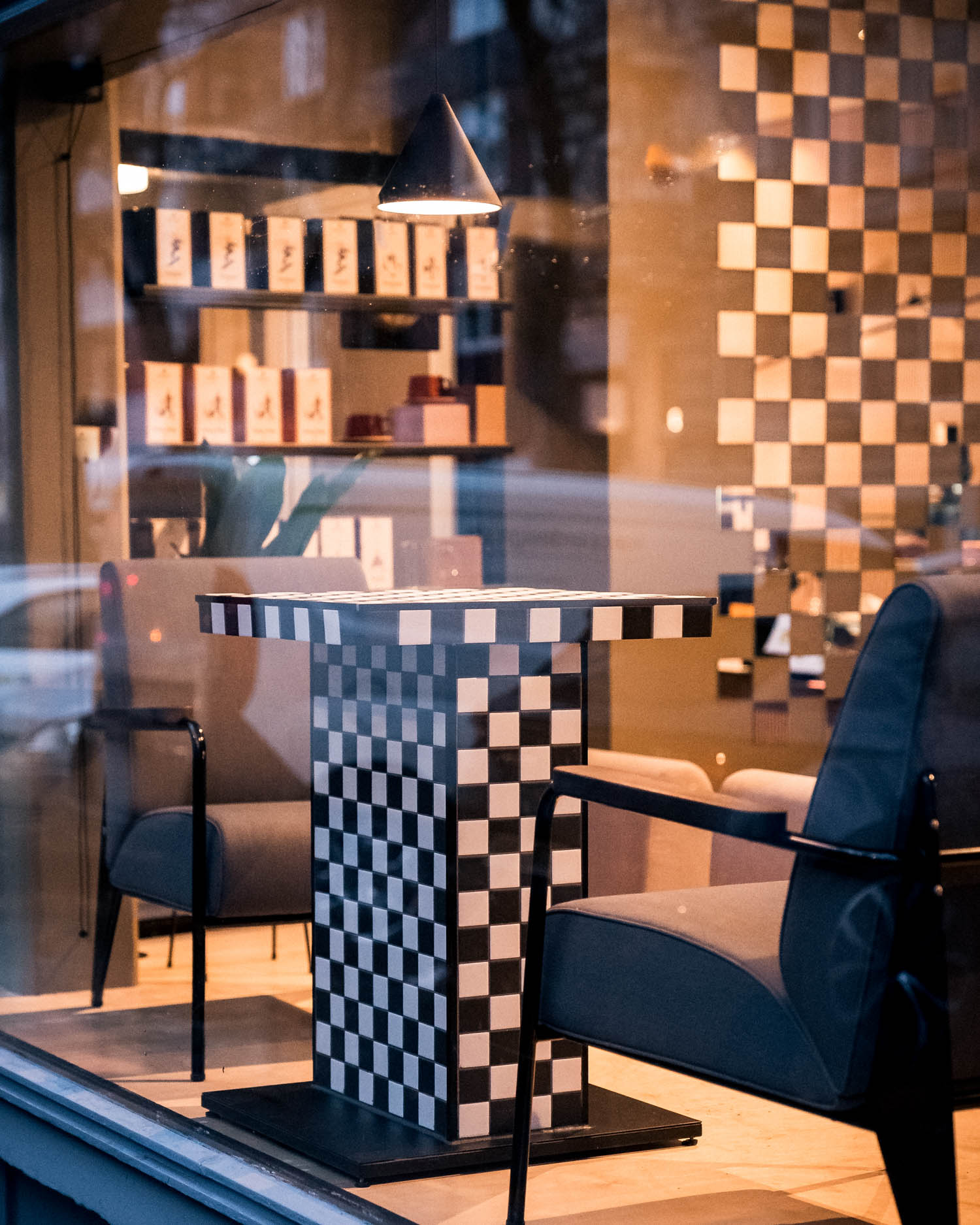
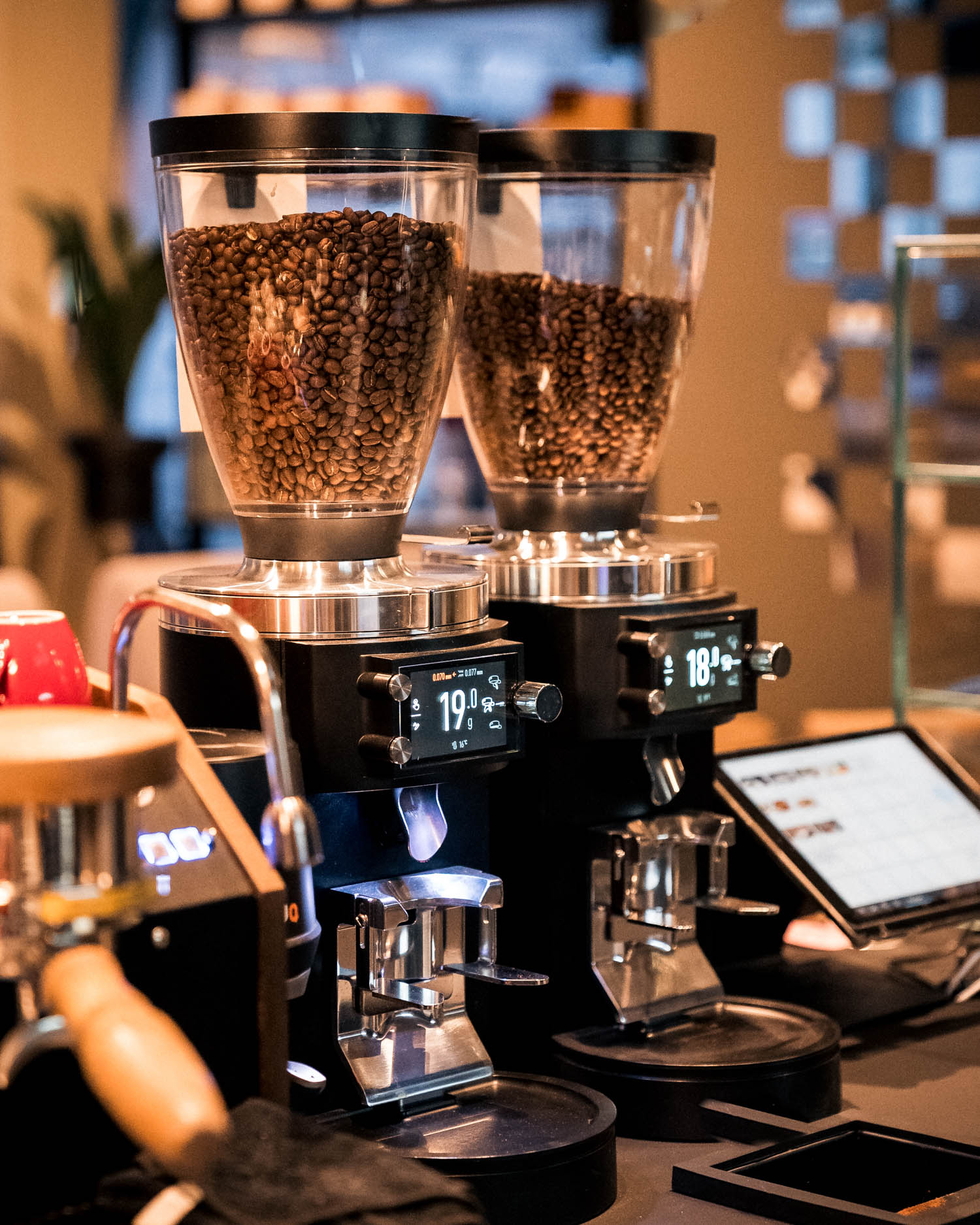
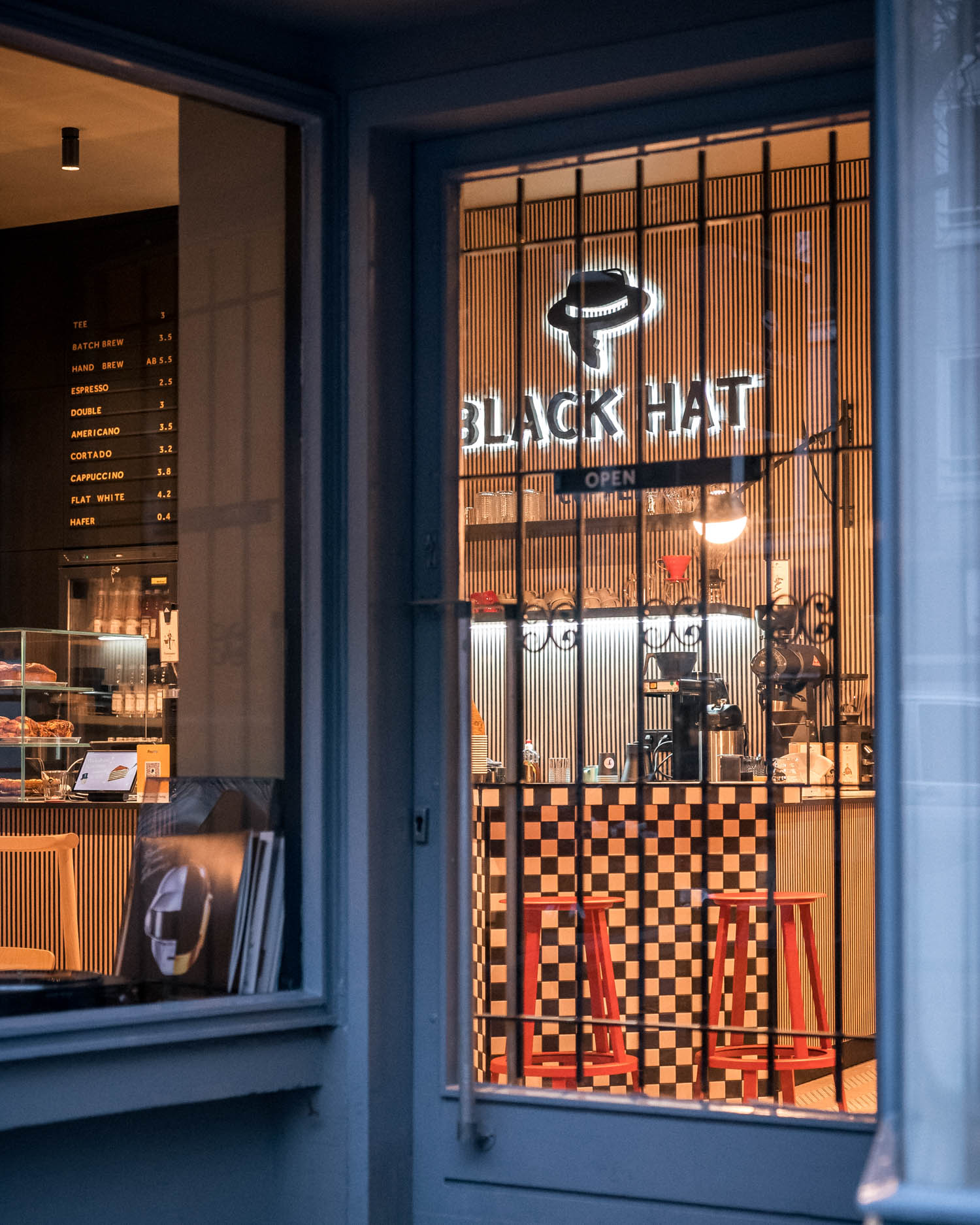
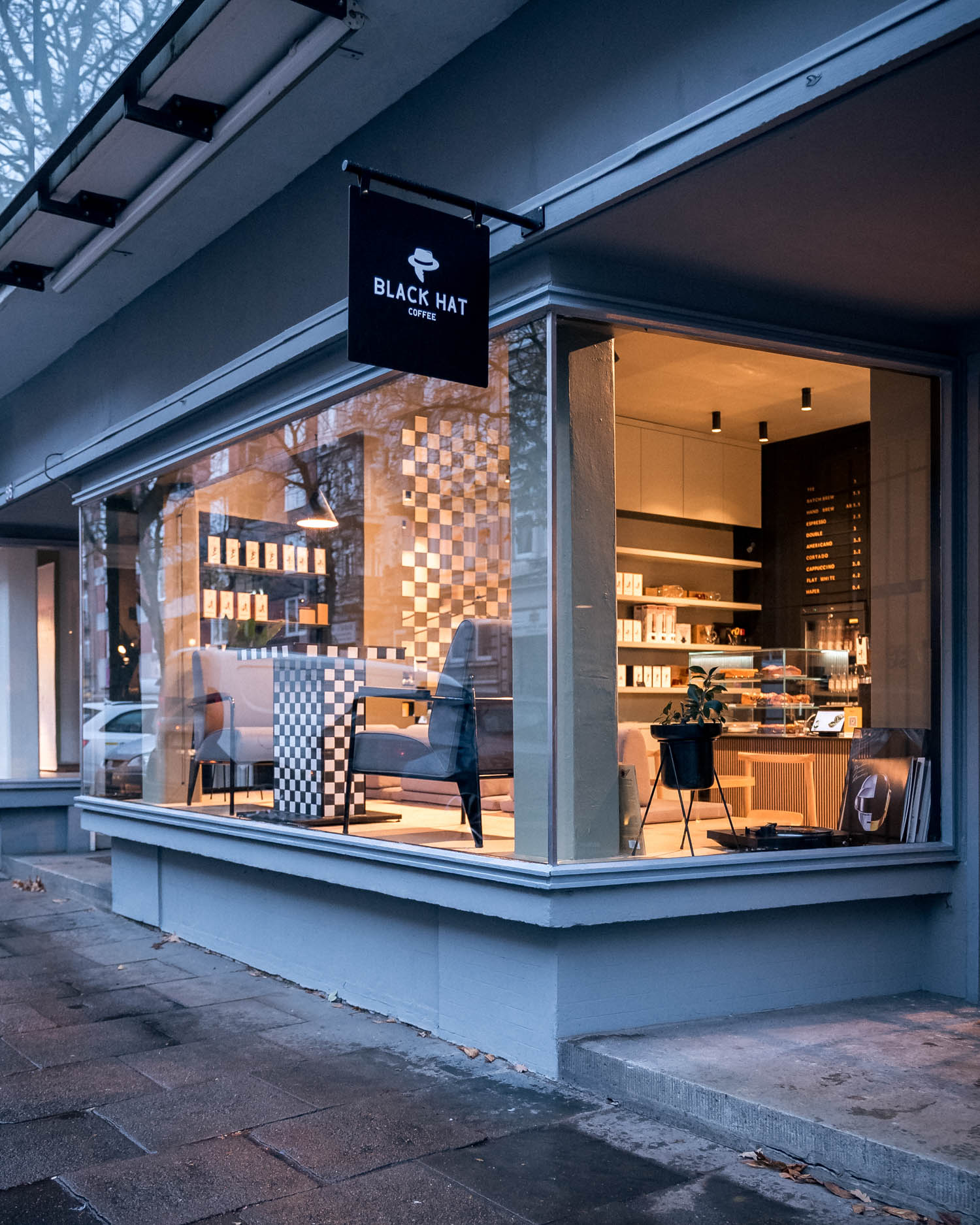
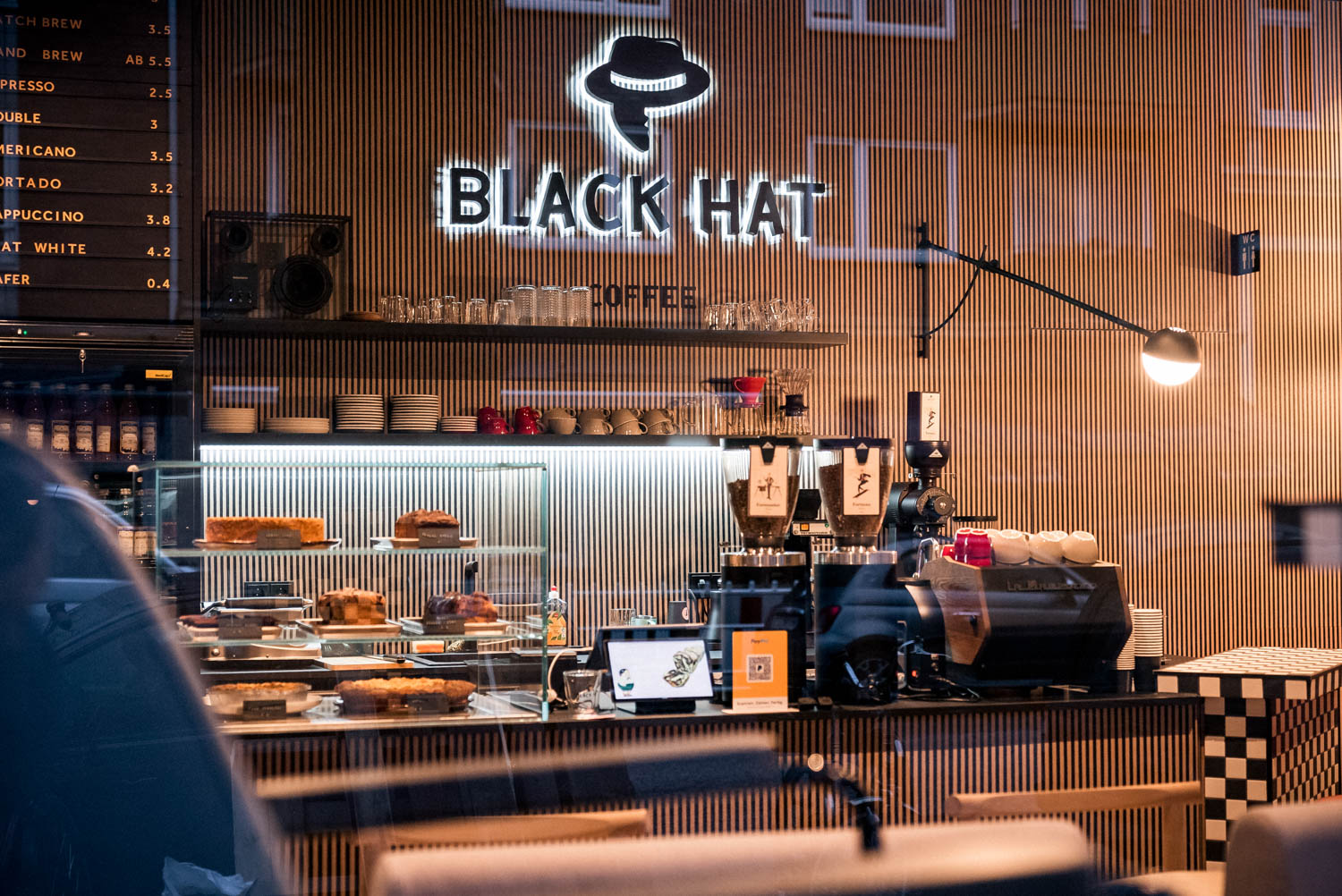
What are the main design features of Black Hat Coffee that set it apart from other cafes in Hamburg?
The thing you see in almost all specialty stores is that they all follow the same aesthetic. Clean design with minimalistic, Nordic approach. Sometimes we think that if the logos on the entryway were changed, you could even tell which coffee shop you were visiting.
One of our wishes was to avoid that, but still be able to stick to our brand values, the highest quality, timeless elegance and also the design elements that we use in our packaging, which I think we were able to achieve.
How did you approach the interior design of your café to reflect the brand’s identity and your personal taste?
We believe that coffee can be as unique as tailor-made suits, a concept that’s beautifully captured in our packaging, which mimics suit designs. Each coffee flavor is associated with a specific suit pattern, allowing our customers to enjoy a consistent experience every time, even if we occasionally change the coffee farm for a particular variety.
By grouping different coffee flavors and linking them to distinct suit patterns on our packaging, we maintain a consistent taste and provide our customers with a visually appealing and easily recognizable experience. This concept extends to our Espresso Bar, where the design echoes our coffee packaging. You’ll find a variety of fabric patterns throughout the space, from the herringbone flooring to the striped counters and checkered tables. Guests can relax in stylish Vitra chairs, enjoying the funky tunes from vinyl records.
This setting is more than just a place to savor a premium cup of coffee; it’s an environment where every detail is crafted to create a memorable and inviting experience.
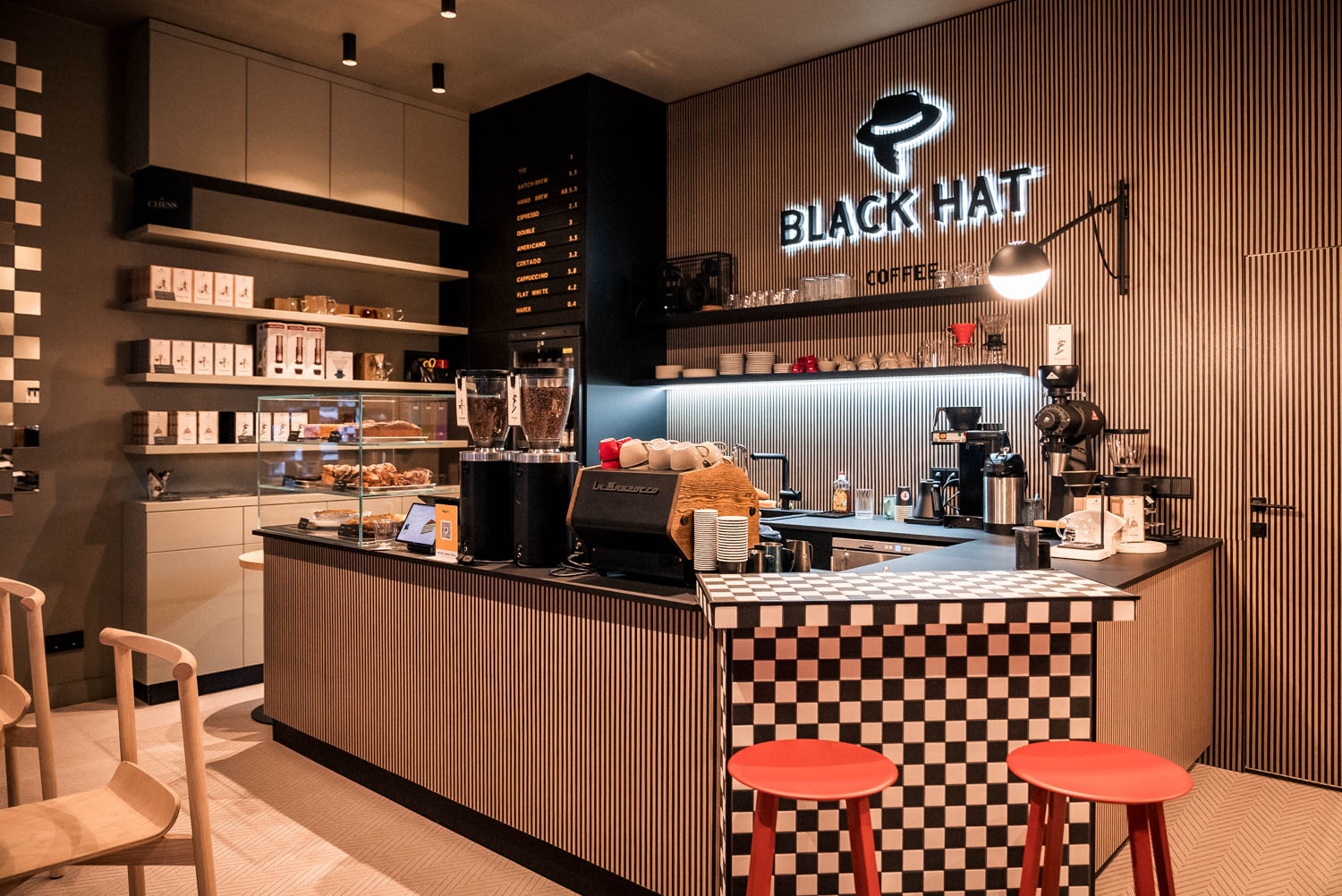
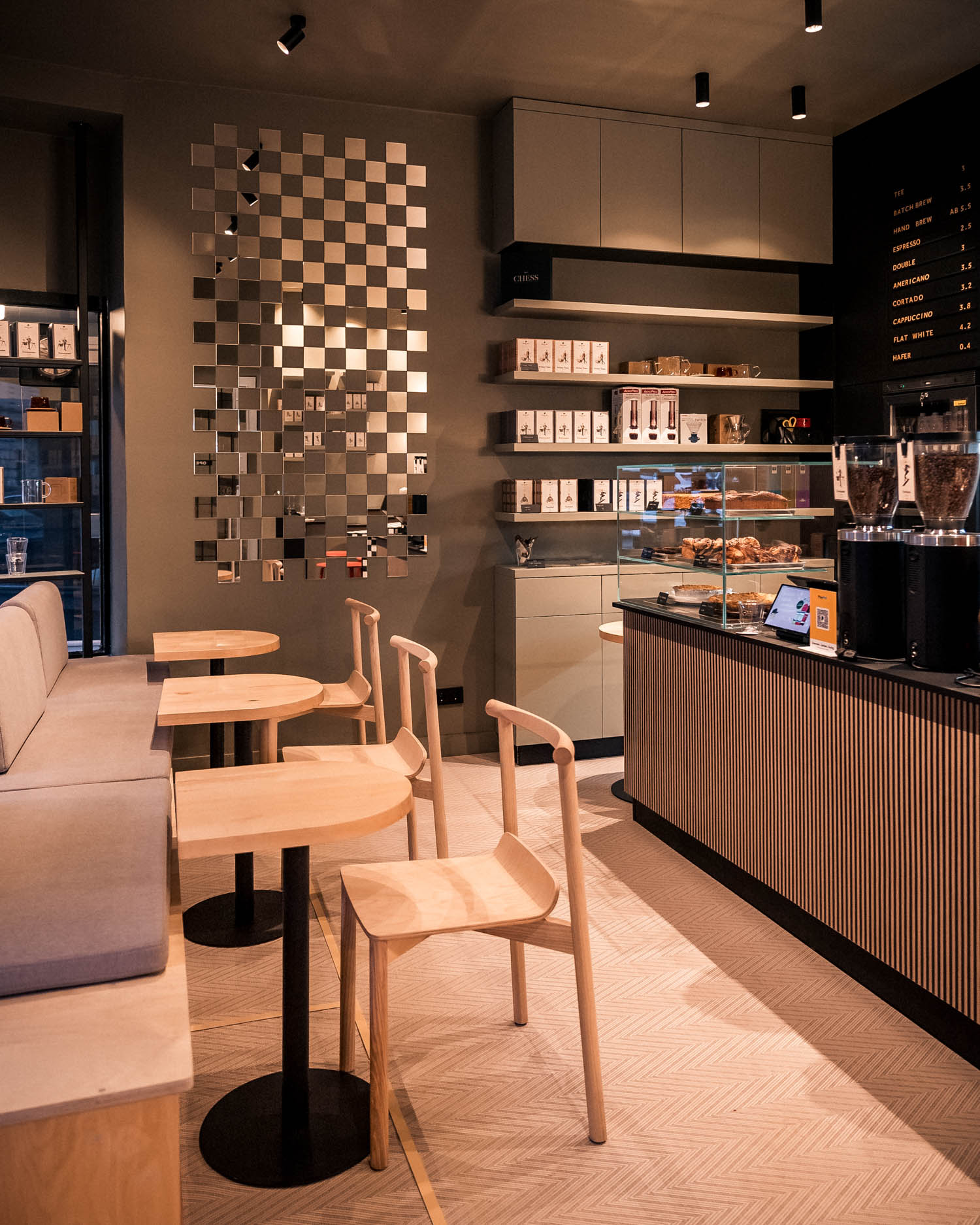
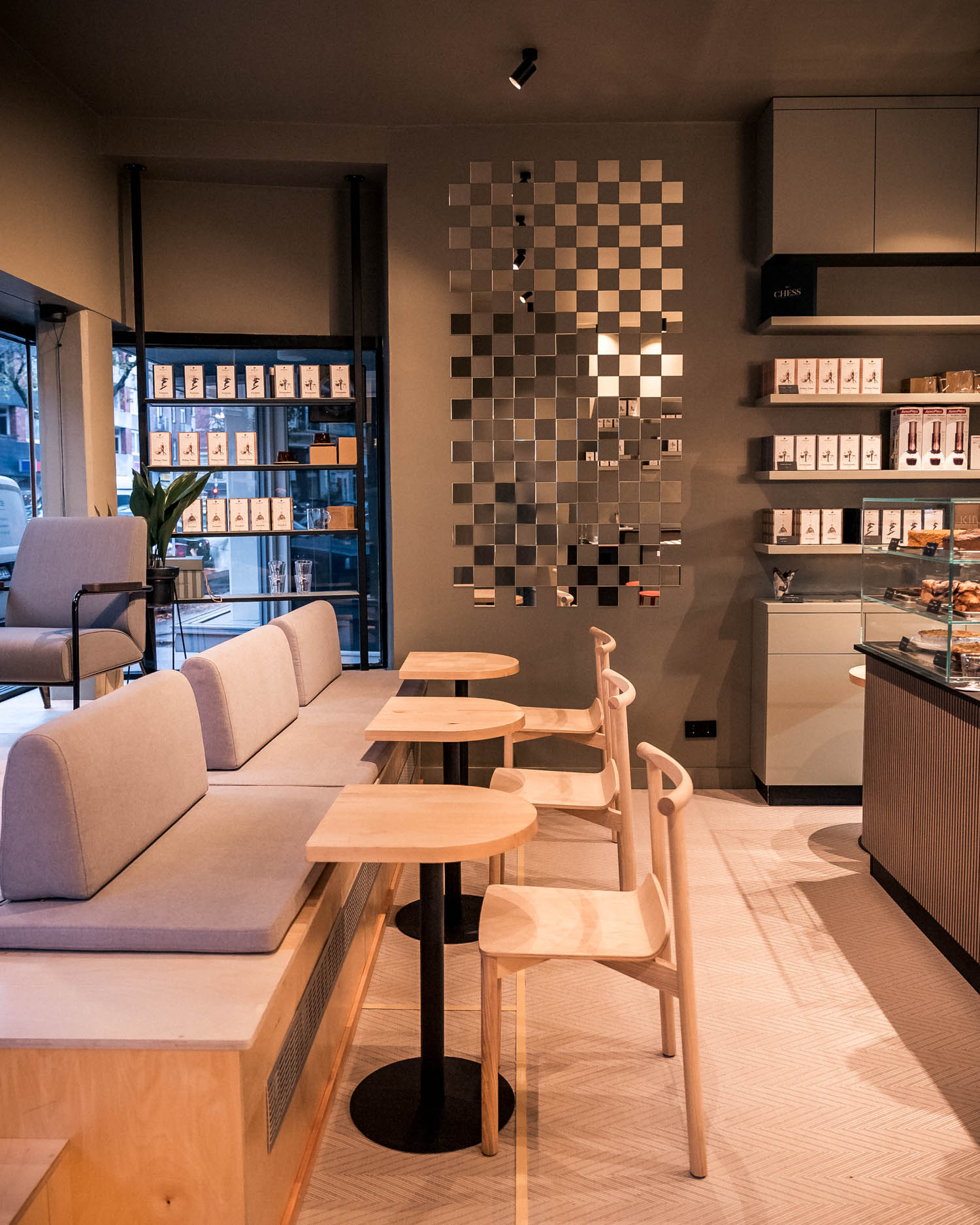
How has the use and vibe of your café space changed over time since you first opened?
Everything is still in the same place and works perfectly, except for two small points:
- Since we play vinyl music in our espresso bar, we found out that modern vinyl players don’t have a replay button, which is a very important function for not disturbing the working process. We got lucky with an old 80’s Technics vinyl player – you can not only use the replay function, but even hang the player on the wall and switch between the songs as if it was a CD – back to the future 🙂
- Since the launch of the first merch collection, we have been looking for a way to present the t-shirts and caps in our cafe, and we got lucky with the lasso coat stand designed by Ukrainian designer Pavel Vetrov, which we are waiting for to be shipped.
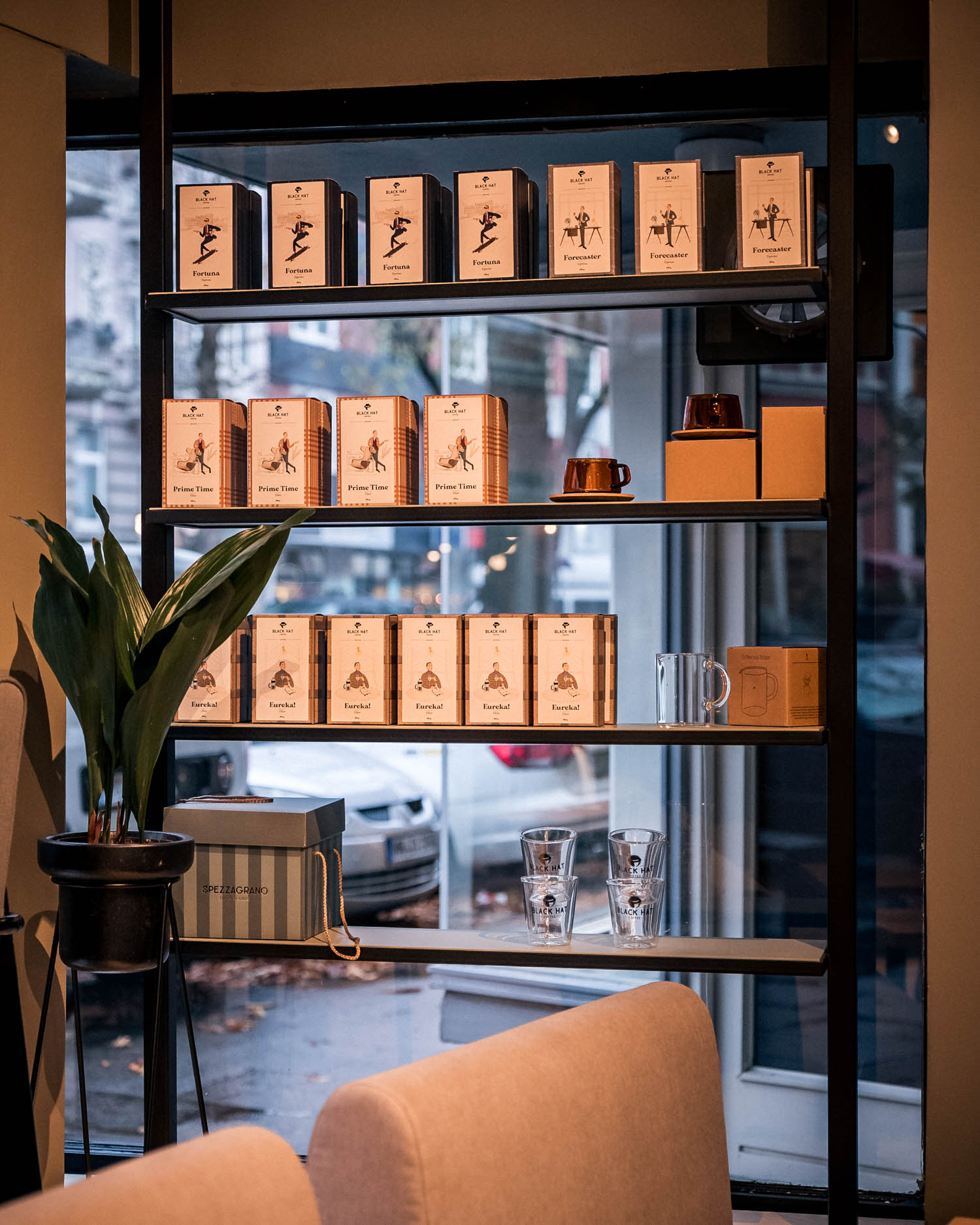
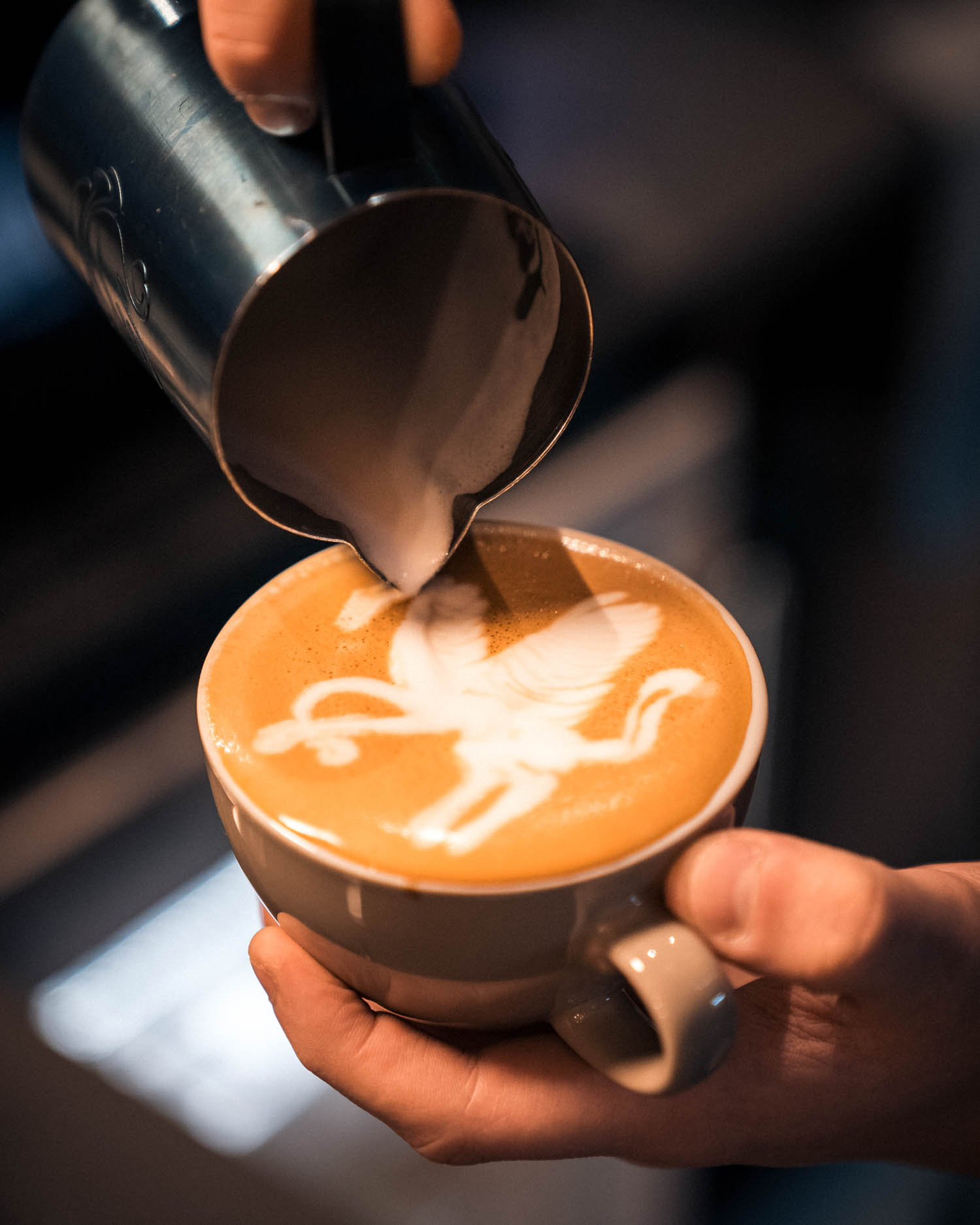
The streetscape around your café is super lively and welcoming in the summer months. Can you describe what you add to your café to welcome people and activate the street?
We have some tables and also custom made benches outside. People can enjoy their coffee and sandwiches. We also have a great cold brew and iced matcha menu for sunny days.
Since some of our tables have a pattern that looks like a chessboard, we thought it would be a good idea to buy giant chess for outside for our guests to play. Sometimes our 11 year old son Daniel plays against the guest – if he wins, the guest will buy a package of coffee – if Daniel loses, the guest gets the coffee beans for free. Win-win.
What role does lighting play in creating the ambiance of Black Hat Coffee, and what specific lighting elements did you incorporate?
Lighting is very important and we wish we had used more LED lighting for the shelves with our products. Perhaps we should consider installing these in the future.
We used Flos String Light to highlight the two seats in the window. We used a Northern Potence lamp to highlight the barista’s work and also two of the FERROLUCE BERIMBAU C2601 ceramic lamps that we really love. In the middle of the room, on the wall, you can see our giant logo with LED backlighting that really stands out – exactly the same elements we would love to see in our next location.
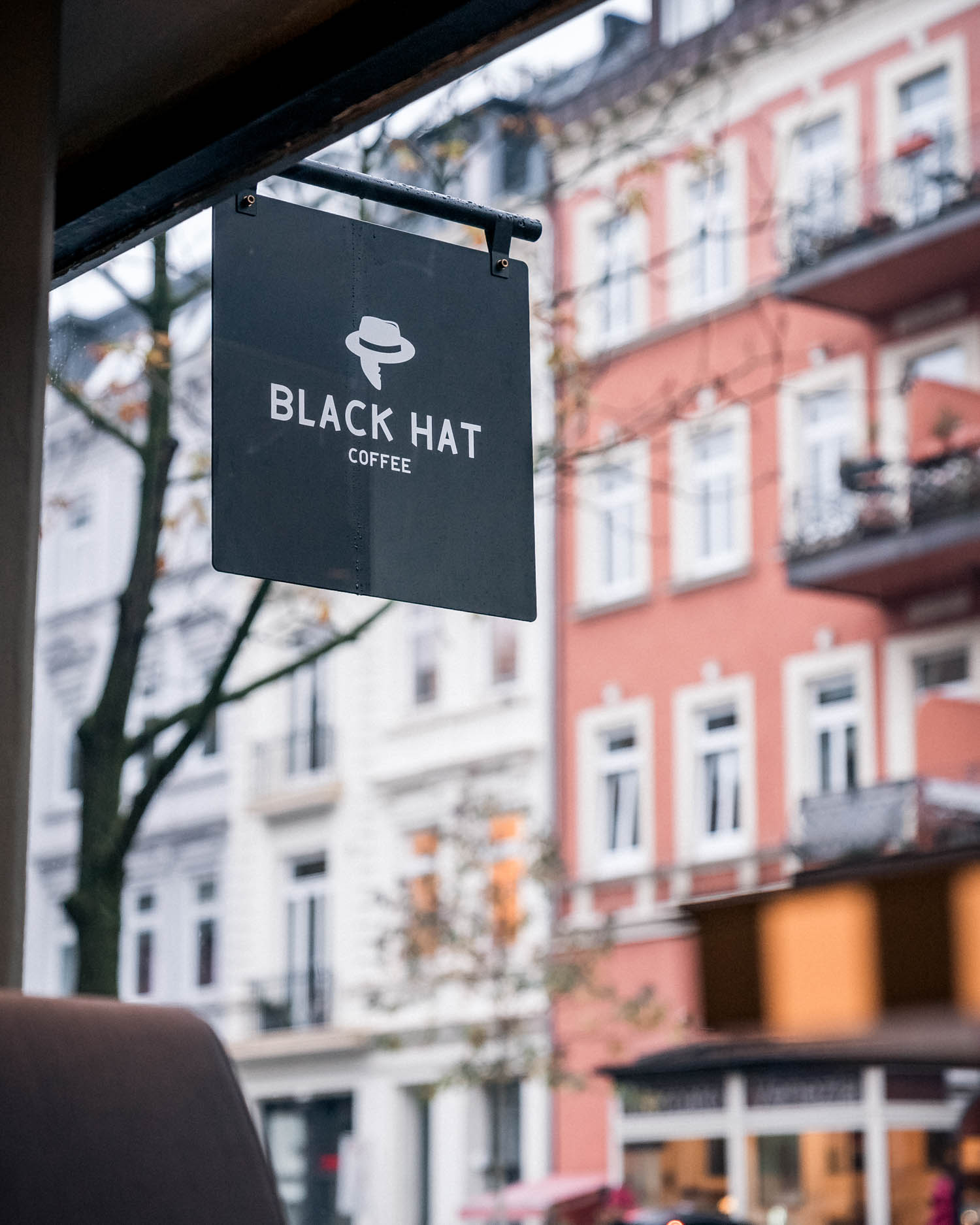
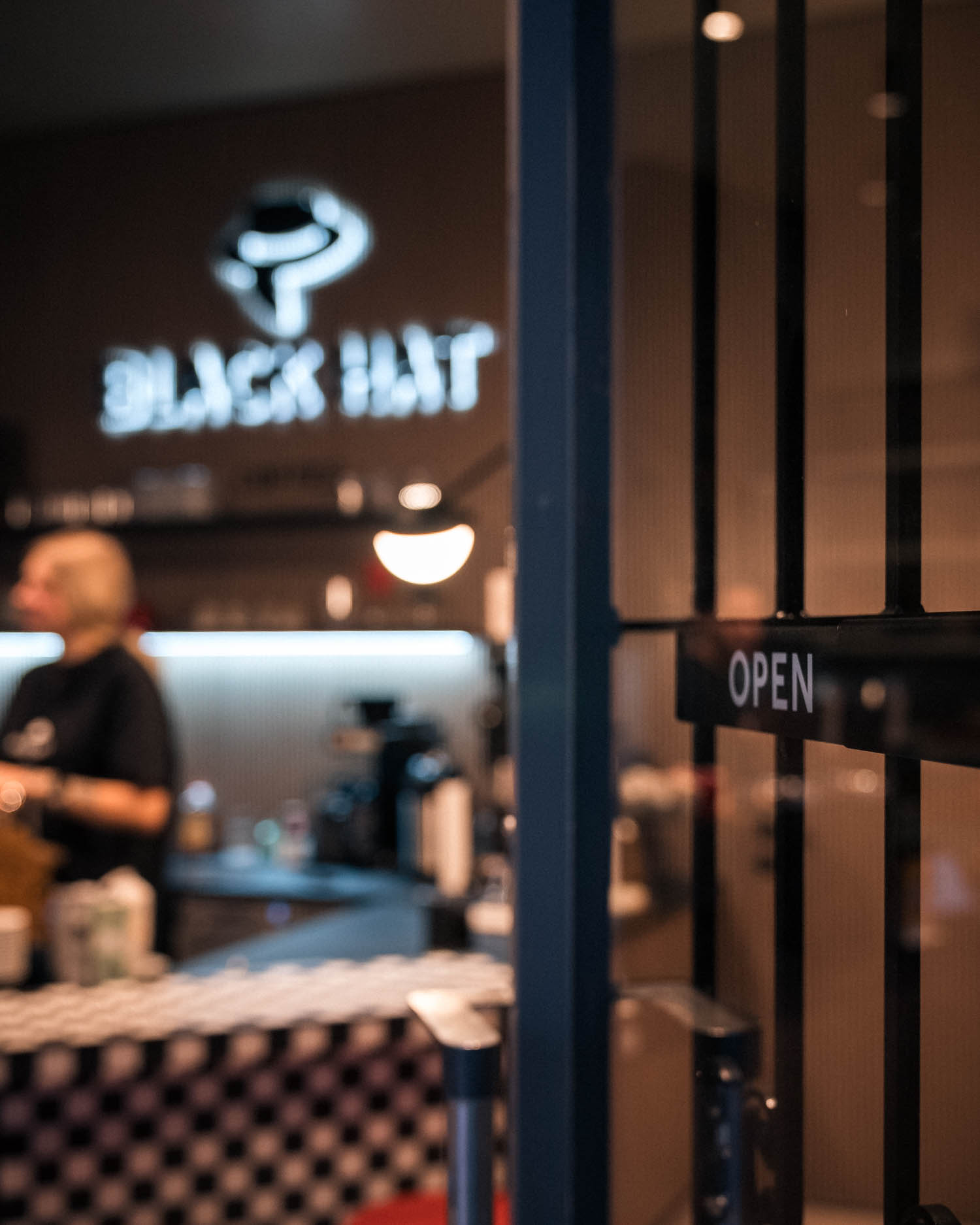
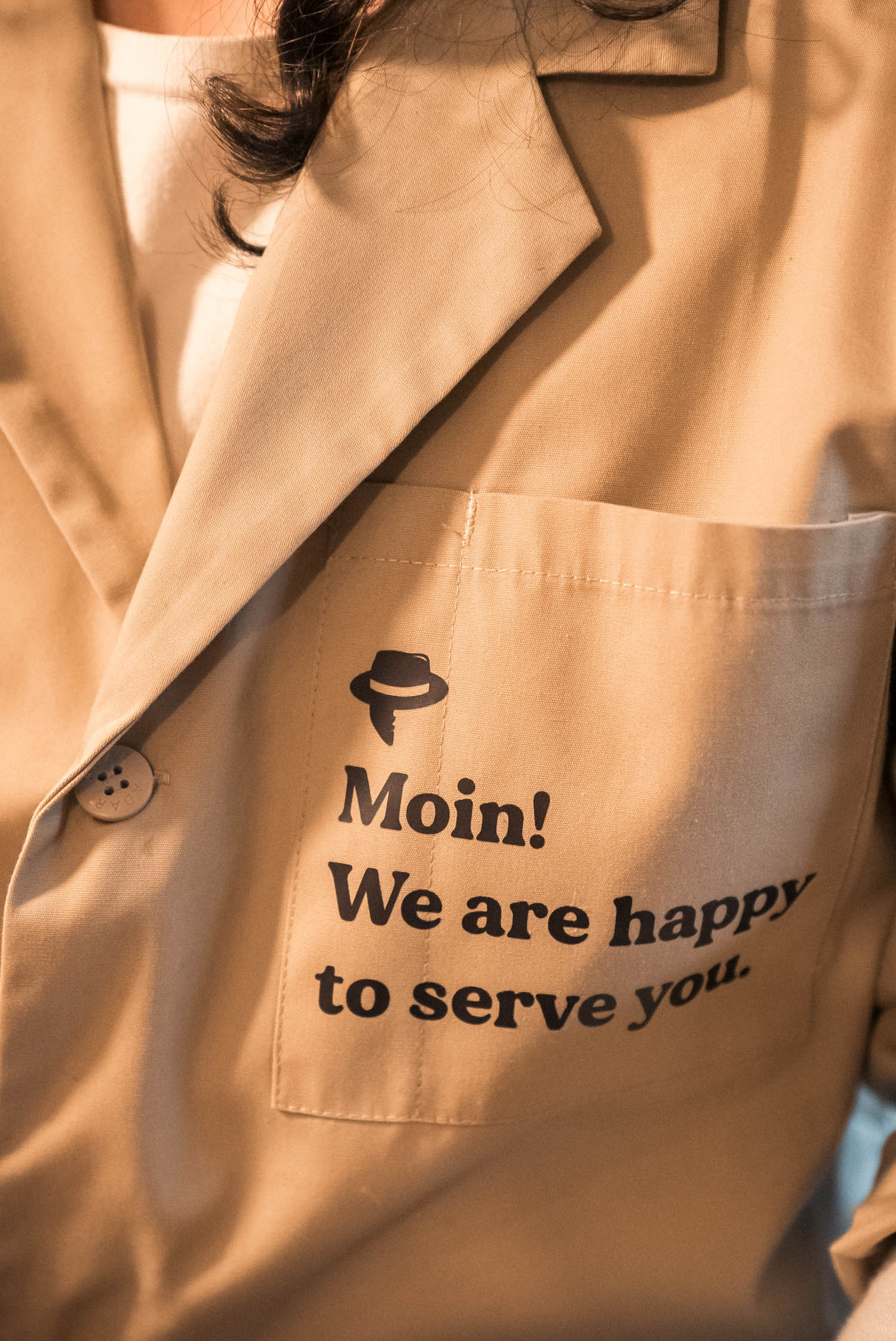
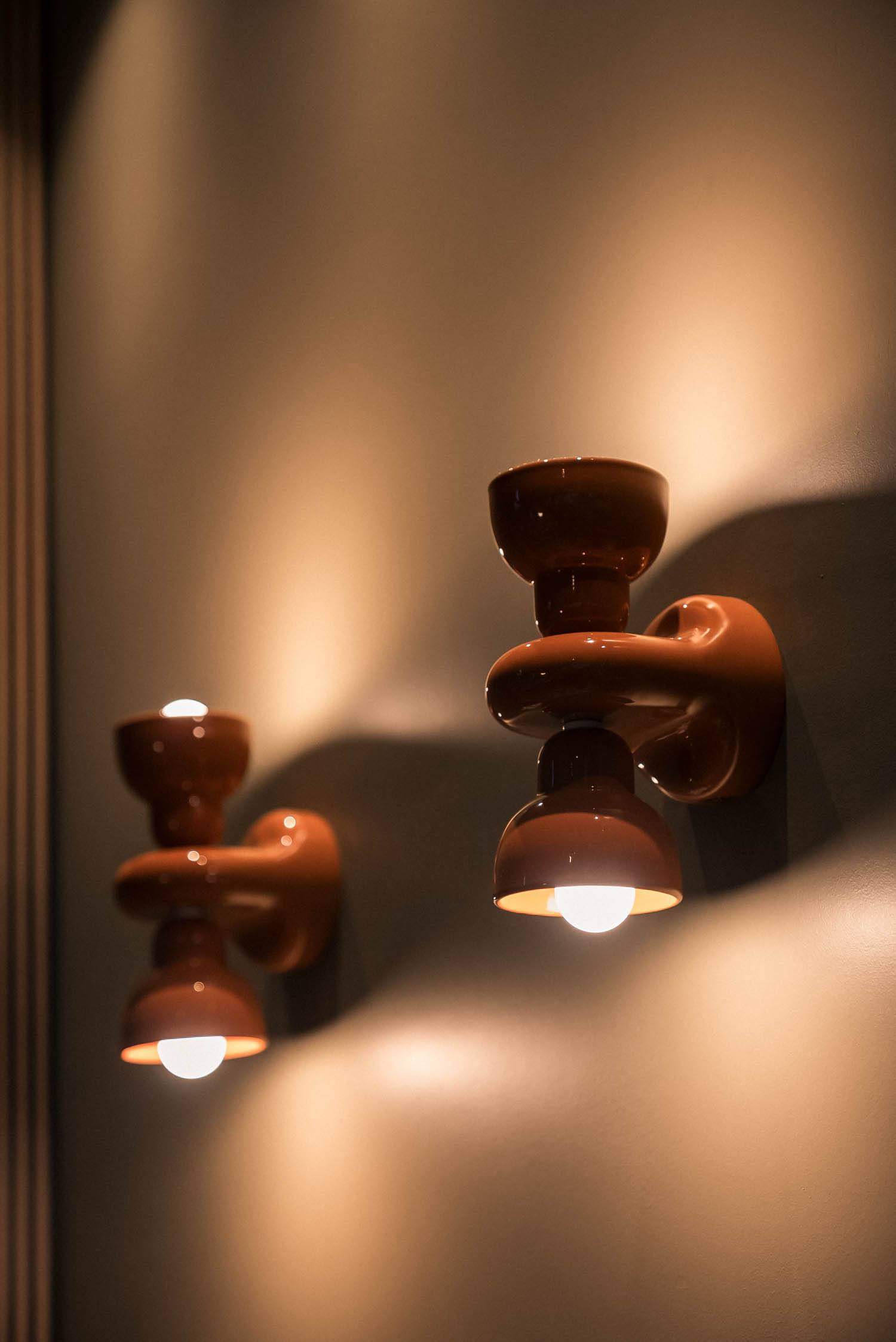
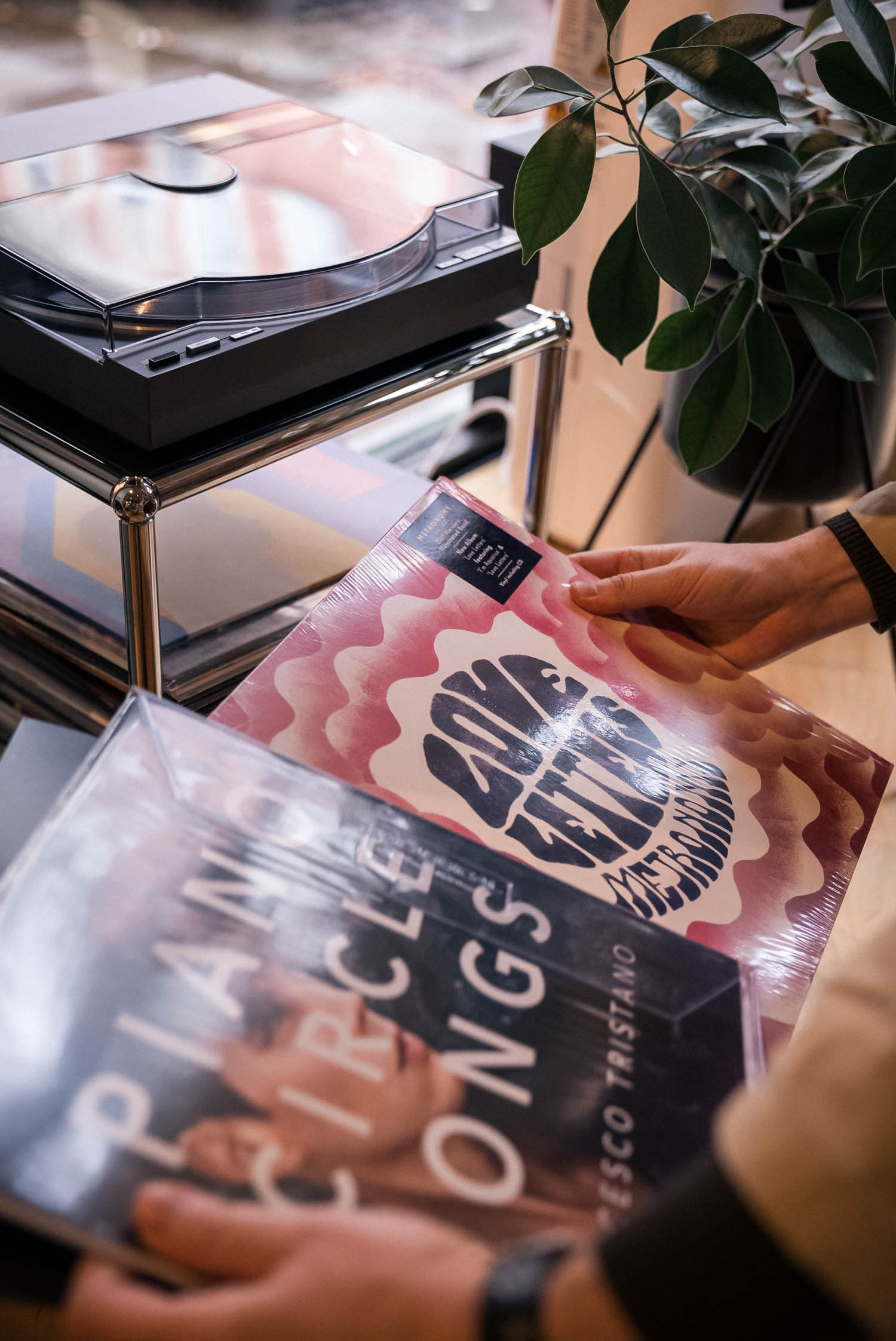
Your coffee machine and other display items really stand out. Can you share what goes into the design and presentation of these items?
Our first machine, the La Marzoco GS3, was ordered in Australia by the mastermind of customisation, Specht. It was customised for us based on the descriptions of our core values and the machine was perfect. Unfortunately or fortunately we have grown and required the 2 group espresso machine for our speciality espresso bar, so we sold our GS3 to a guy who had just purchased a camper van and was going to travel around Europe selling coffee – we thought that would be a romantic future for our GS3. Now we have the Syneso S200 which was also customised for us. I would like to order another machine from Specht one day.
The Sings we have were mostly ordered by George and Willy – they are great!
How do you integrate Ukrainian cultural elements into the design and overall experience at Black Hat Coffee?
Word has spread around Hamburg that we are Ukrainian, leading many nostalgic visitors to seek out a Ukrainian café, which we are not. Although we occasionally serve cakes reminiscent of our childhood, such as Napoleon Cake or Honey Cake, our menu is diverse. You’ll often find treats such as cinnamon and chocolate babka, Reuben sandwiches and, of course, specialty coffee. Our clientele is cosmopolitan, spanning all ages and with a keen appreciation of high quality, design, coffee and music.
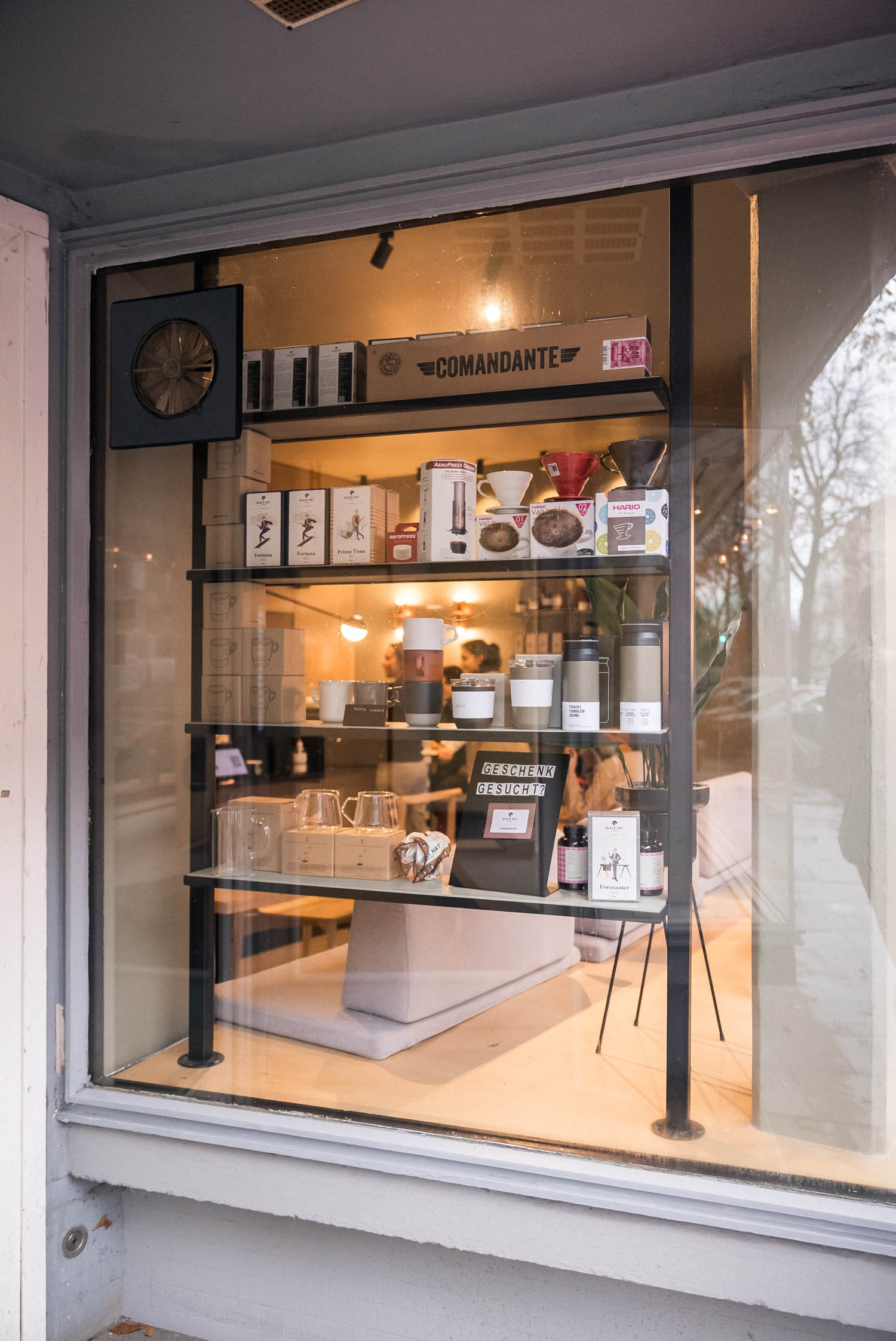
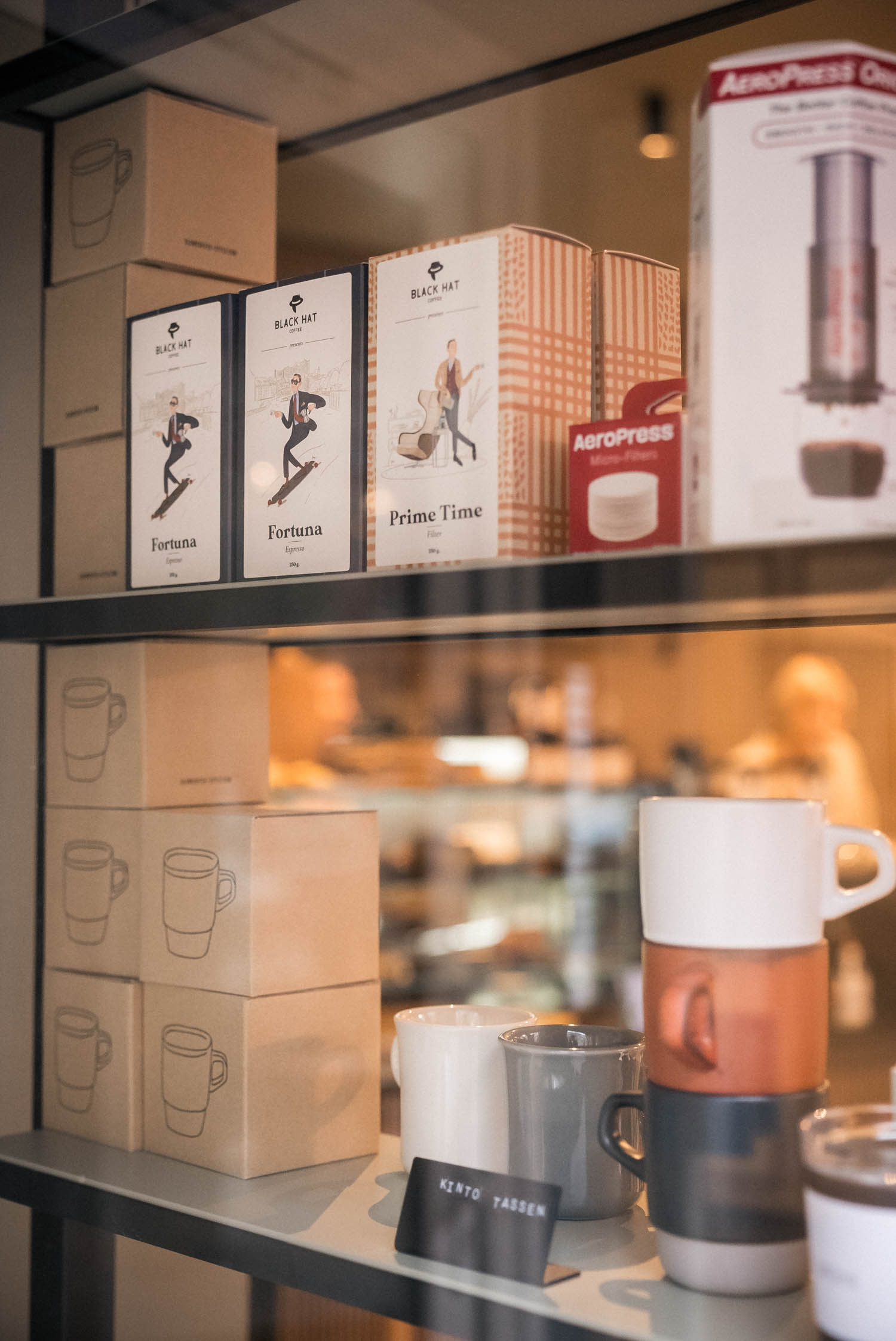
What kind of community do you hope to build around your café, and how do you plan to foster that sense of community?
The community and our regular customers don’t just seek to buy the cheapest and consume quickly, but allow us to experiment with higher priced green coffees, for example, because they want to try new things and appreciate the elements that Black Hat Coffee brings together.
After about a year and a half after opening, our processes are really good, our workflows, team structure and partner network are truly excellent, so we can start to experiment even more.
At Black Hat Coffee we are passionate about fermented coffee beans, which we love to hand brew for our customers to give them a new taste experience, so I want to do more variations in that direction, and we miss food on our menu and are considering introducing snow crab buns. Yummy.
What are some of your favourite interior design features of Black Hat Coffee, and why did you choose them?
One of my favourite elements is the Bolon floor – it is so unusual to have a floor that fits in perfectly with the environment. Our floor has a herringbone pattern – 100% fitting with our coffee packaging design. I love the Vitra Jean Prouvé chairs, of course, but to be honest, the bespoke furniture we have, such as checked tables and mirrors, are really great too.
Looking to the future, how do you envision Black Hat Coffee evolving in terms of design and customer experience with your upcoming Berlin location?
We may switch from the current bistro tables to the custom Ardamez bistro tables, but we want to keep the same design in the future locations and focus on expanding some of the already beloved elements, for example the music component, which we play with vinyl in the current location, we will expand to a DJ booth to play live sets in the second location. But I do not want to spoil too much and would like to see you at our place.
